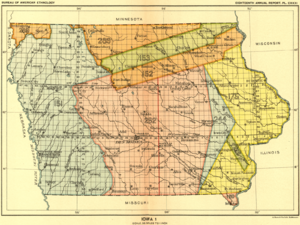Black Hawk Purchase facts for kids
The Black Hawk Purchase was a large area of land in what is now Iowa. It was also known as the Forty-Mile Strip or Scott's Purchase. This land stretched along the west side of the Mississippi River. It went from the northern border of Missouri up to the Upper Iowa River in the northeast part of Iowa.
The land was originally home to the Sauk, Meskwaki, and Ho-Chunk (Winnebago) Native American tribes. The United States government acquired this land after defeating these tribes in the Black Hawk War. After the war, the Sauk and Meskwaki people had to give up about 6 million acres (24,000 square kilometers) of land. They also lost their rights to plant, hunt, or fish on this land.
The purchase was completed on September 21, 1832, for $640,000. This was like paying about 11 cents for each acre. The area was named after the Sauk leader Black Hawk, who was held as a prisoner at that time. The Black Hawk Purchase included important places like Dubuque, Fort Madison, and today's Davenport.
Making the Purchase Official
The agreement for the Black Hawk Purchase was made by General Winfield Scott and John Reynolds, who was the Governor of Illinois. They met in what is now Davenport, Iowa, on the west bank of the Mississippi River.
The United States government officially approved this agreement on February 13, 1833. The land was then opened for settlement on June 1, 1833. This made it the first part of what would become Iowa that was open for people from the United States or Europe to settle.
What the Land Included
The Black Hawk Purchase was a long strip of land. It followed the western side of the Mississippi River. It was about 50 miles (80 km) wide at its northern and southern ends. In the middle, it was about 40 miles (60 km) wide.
Different historical records describe the exact borders slightly differently. Generally, it stretched from the northern border of Missouri almost up to Minnesota. It included areas that would later become parts of many counties in Iowa.
Special Land Areas
Within the Black Hawk Purchase, two special areas were set aside. One area was given to the Sauk chief Keokuk and his people. This was a thank-you for them staying neutral during the Black Hawk War. This area later became known as Keokuk's Reserve.
Another special area was given to Antoine LeClaire. He was a "half-breed" translator, meaning he had both Native American and European heritage. This land was different from another area called the Half-Breed Tract, which was set aside earlier.
The land from the Black Hawk Purchase was governed by different territories over time. First, it was part of the Michigan Territory. Then, it became part of the Wisconsin Territory, followed by the Iowa Territory. Finally, it became part of the state of Iowa.
The Black Hawk Purchase was followed by other land purchases. These included the Second Black Hawk Purchase in 1837 and the New Purchase in 1842.


